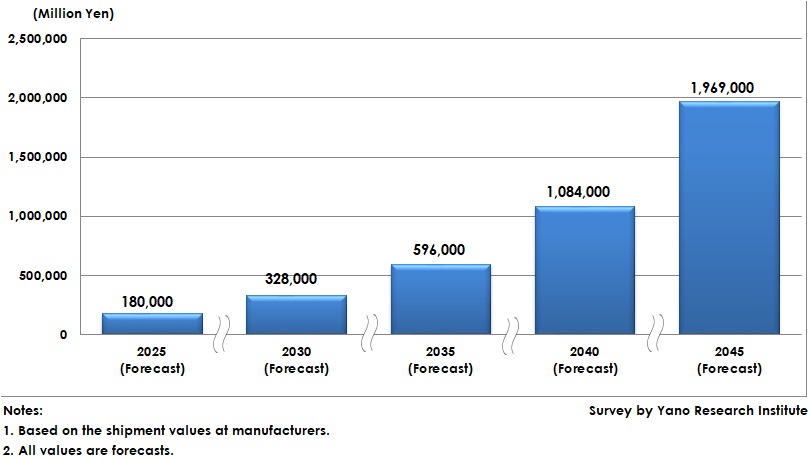No.3413
Global Market of Organic Field Effect Transistors (OFETs): Key Research Findings 2023
Global OFET Market Size Expands to 180,000 Million Yen by 2025
Yano Research Institute (the President, Takashi Mizukoshi) has conducted a survey on the global markets of organic, next-generation devices and found out the trends of R&D institutions by device type, by application (system), and future perspectives. Here clarifies the forecast of global organic field effect transistor (OFET) market size.

Market Overview
An organic field-effect transistor (OFET) is a field-effect transistor that controls the current by using an organic semiconductor in an active layer. The semiconductor industry has prospered by inorganic materials with quality properties represented by silicon (Si), but such inorganic semiconductors are facing the limitation to die shrink. This has belatedly brought forth organic semiconductors that have excellent features not found in inorganic ones. In addition, An OFET can be fabricated through a solution process in which organic semiconductor materials are made into a solution and coated onto a substrate by spin-coating or other methods. The device is being developed to apply to low-cost, large-area, and flexible electronic products.
OFETs can utilize a vast variety of materials when compared to inorganic materials. In addition, freedom of designing organic molecules, extensive potential in membrane structures, and diversifying fabrication processes can be sited as the advantages. The details are as below.
Firstly, the fabrication processes are simple. As can be dissolved into liquid, it is easy to express complicated patterns by using inkjet printers. With an OFET, devices can be fabricated at temperatures as low as 200°C or lower and combined with heat-sensitive films or plastic substrates.
Secondly, An OFET has the freedom to design molecules. It can freely place a substitute, change the length of a benzene ring, and synthesize organic transistors with some changes in designs added little by little.
Thirdly, it has excellent flexibility. As the materials of an OFET are π-conjugated organic materials, not only can films be formed, but they can also be rolled up and bent. This indicates that the form of displays that used only to be square and flat can be shaped into flexible forms if made from organic semiconductors.
Such characteristics of OFETs are expected to play a significant role in the application field development which includes biosensors, driver circuits for displays including flexible electronic devices, wireless (information) tags such as radio frequency ID, integrated circuits for high-performance mobile terminals, etc.
Noteworthy Topics
Progress in Development of OFETs that Work in Ultrashort Waveband
In the development of OFETs, the maximum responsive frequency has reached 38MHz, the fastest in the world. As this value is by far larger than 13.56MHz, the communication frequency of radio frequency ID tags widely used for logistics management, etc., it is already at the level sufficiently applicable for powering wireless tags. Furthermore, because ultrashort waveband has been used for FM radio broadcasting or for the amateur radio, future increase in rapid responsiveness can expect realization of organic integrated circuits that allow long-distant radio communications using ultrashort waveband.
As OFETs can be mass produced through relatively simple printing processes, they are envisioned for a wide range of applications such as low-cost wireless tags that can be employed for logistics management that plays leading roles in the future IoT society and wireless charging systems that supply electricity from electromagnetic waves.
Future Outlook
The global OFET market size (based on the shipment values at manufacturers) is projected to be 180,000 million yen by 2025, and to reach 1,969,000 million yen by 2045, 10.9 times larger than that of 2025.
When observing the global market by device application, driver circuits for displays is anticipated to occupy the largest share at 59.4%, followed by biosensors at 13.9%, chemical sensors 11.1%, and others accounts for 15.6%. The perspectives for organic devices that have quality properties that no inorganic devices have are bright.
Research Outline
2.Research Object: R&D institutions developing organic field-effect transistors (OFETs), producers and distributors of OFETs
3.Research Methogology: Face-to-face interviews (including online) by expert researchers and literature search
About Organic Field Effect Transistor
An organic field-effect transistor (OFET) is a field-effect transistor that controls the current by using an organic semiconductor in an active layer.
An OFET can be fabricated through a solution process in which organic semiconductor materials are made into solution and coated onto a substrate by spin-coating or other methods. The device is being developed to apply to low-cost, large-area, and flexible electronic products.
<Products and Services in the Market>
Organic Field Effect Transistor, OFET
Published Report
Contact Us
The copyright and all other rights pertaining to this report belong to Yano Research Institute.
Please contact our PR team when quoting the report contents for the purpose other than media coverage.
Depending on the purpose of using our report, we may ask you to present your sentences for confirmation beforehand.